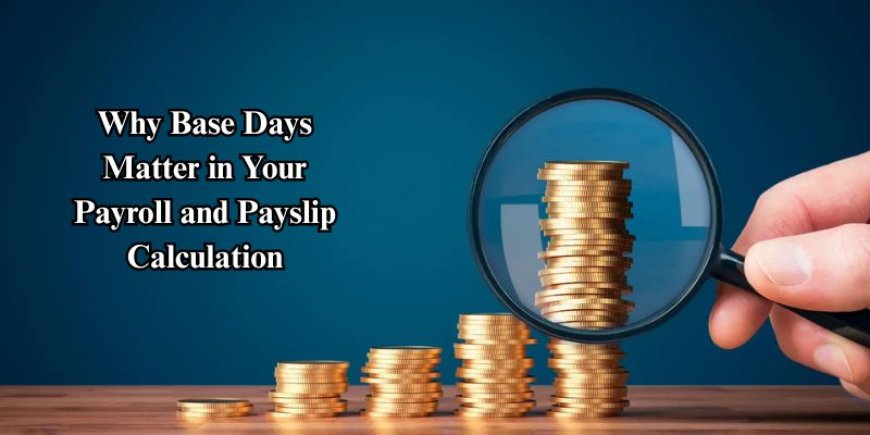Why Base Days Matter in Your Payroll and Payslip Calculation
Base days silently shape your salary by determining how your monthly pay is calculated, especially during leaves or partial work periods. Understanding them ensures fair pay, accurate deductions, and transparency in your payslip.

When payday rolls around, most employees eagerly check their bank balance or download their payslipbut how many truly understand what goes into the numbers listed there? Among the various details behind your salary calculation, base days play a quiet yet powerful role. They might seem like a small line item, but they shape the accuracy of your earnings, deductions, and benefits. If you've ever wondered why your take-home pay feels a little different from last month, the answer might be hiding in the base days used in payroll computation.
In this article, well unravel the importance of base days in payroll and payslip calculationand why getting them right can make a huge difference for both employees and employers. As more businesses seek streamlined and compliant payroll services in India, understanding base days becomes essential for ensuring fair pay and avoiding payroll discrepancies.
What Are Base Days in Payroll?
Base days refer to the number of days considered as the standard or benchmark for calculating salary for a particular month. This number usually corresponds to:
-
The total calendar days in a month (28, 30, or 31 days),
-
The number of working days, or
-
A fixed number such as 30 days (used for simplified calculations in many payroll systems).
This value becomes the denominator in the payroll equation. For instance, if your monthly salary is ?60,000 and the base days used are 30, then each day is worth ?2,000. If youve worked for 25 days, your gross earnings will be ?50,000 for that month.
Seems simple, right? But heres the twistchanging the base days can significantly affect the figures on your payslip.
Why Base Days Are Not "Just a Number"
1. They Define Your Daily Worth
Your salary is typically given as a monthly figure, but behind the scenes, its broken down into daily portions. The base days determine this breakdown. If the month has 31 days but your payroll system always uses 30 as the base, the value of each working day becomes slightly higher. On the flip side, if Februarys 28 days are used as a base, each day becomes more valuableand taking leave in such a month could hit your salary harder.
Lesson? Base days directly affect how much you earn (or lose) per day.
2. They Affect Leave Deductions
Lets say youve taken 2 days of unpaid leave. The amount deducted from your salary depends entirely on how base days are defined.
-
If 30 base days are used:
?60,000 30 2 = ?4,000 deduction
-
If 31 base days are used:
?60,000 31 2 = ?3,870 deduction
Thats a ?130 difference for just 2 days. Multiply that over several months or employees, and it adds up fast.
3. They Impact Partial Month Payments
For new joiners or employees leaving mid-month, salary is calculated on a pro-rata basis. Base days come into play here in a big way.
Example: You join on the 15th of a 30-day month.
With ?60,000 monthly salary and 30 base days, your pay = ?60,000 30 16 = ?32,000
But if your payroll uses actual calendar days (31 days in July), your pay = ?60,000 31 17 = ?32,903
This difference might be small on paper but significant in employee perceptionand company budgeting.
4. They Determine Bonus and Overtime Fairness
Bonuses, overtime, and incentives often piggyback on the base day logic. If the base day calculation is inconsistent or unclear, employees may feel theyre being shortchangedor companies may accidentally overpay.
To maintain transparency and trust, defining and consistently applying base days is a non-negotiable payroll hygiene rule.
5. They Influence Payroll Compliance and Accuracy
Payroll is not just about mathits also about compliance. From tax deductions to statutory benefits like PF, ESI, and gratuity, accurate earnings computation is vital. Misalignment in base day calculation can lead to incorrect statutory deductions or wrong tax liability, which may trigger audit red flags or legal hassles.
In simple words, base days are like the nuts and bolts of a well-oiled payroll engine. One loose screw, and the whole system wobbles.
Common Base Day Practices
Different organizations adopt different methods. Lets take a quick peek at popular choices:
? Fixed 30 Days
This is the most commonly used method for simplicity. It standardizes payroll and avoids monthly variation.
? Actual Calendar Days
Some companies use the actual days in each month (28/30/31). This method is more precise but can complicate calculations.
? Working Days Only
This approach considers only the number of actual working days in a month (excluding weekends and holidays). It's popular for hourly or daily wage earners.
Each method has its pros and cons. The key is to choose one and stick with it consistently across all payroll processes.
Transparency Is Key
Lets face itmost employees dont ask questions until theres a problem with their pay. But proactive transparency around how salaries are computed, including base day definitions, builds trust and reduces disputes.
Including base days on payslips, along with clear leave balances, present days, and salary calculations, can make payroll feel less like a mystery and more like a well-oiled machine.
Best Practices for Payroll Teams
-
Define a clear base day policy and document it in HR and finance manuals.
-
Align payroll software or spreadsheets with this policy to avoid inconsistencies.
-
Train HR teams to handle queries around base days and payslip calculations.
-
Communicate with employeesespecially during onboarding, exit, or policy changes.
-
Audit your payroll process regularly to ensure accuracy and legal compliance.
Why It All Adds Up
At the end of the day (or month), every rupee matters. Whether youre the one preparing the payroll or receiving the payslip, understanding how base days influence salary brings clarity, confidence, and fairness to the table.
In a world obsessed with big numbersbonuses, CTCs, tax slabsits the smaller numbers like base days that quietly decide how much actually lands in your account.
So, next time you glance at your payslip and wonder how a few leaves shaved off a chunk of your earnings, remember: its not just about days worked. Its about which days were counted.









































